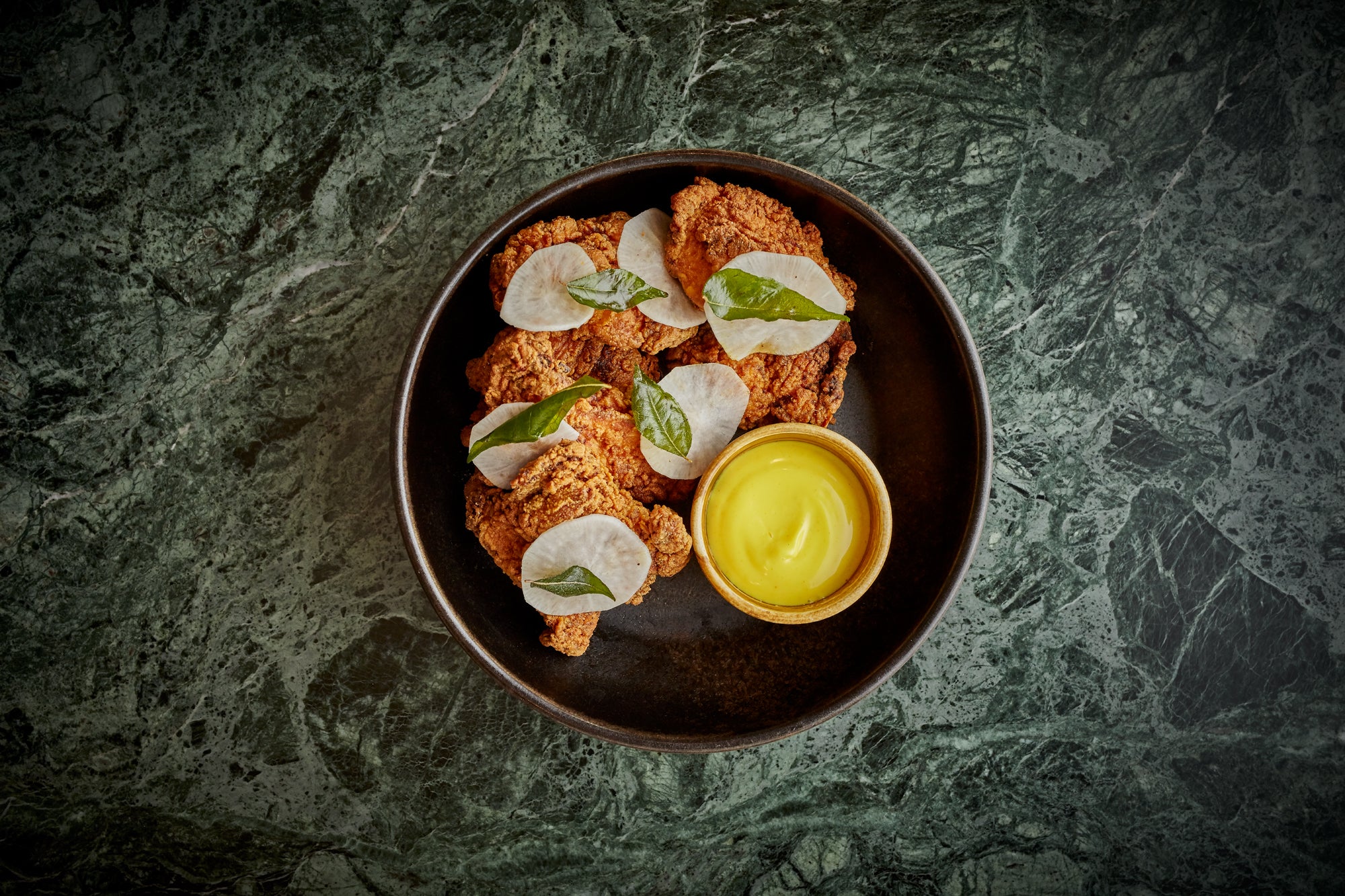How to cook the most popular dishes from three of our favourite restaurants
In case you weren’t already excited to revisit Kricket, Bubula and Fuku when they reopen, here’s their top recipes to whet your appetite. By Sean Russell


The restaurants are opening again and we can almost taste the end of lockdown. We are once again able to sit at a table with friends, eating great food, drinking wonderful wine and and simply enjoying not being at home.
But while it has certainly been a tough time for the customers of restaurants, and those that thrive on a full schedule of new restaurants to try, it has been even harder for the restaurant owners and staff… and unfortunately it isn’t over yet.
Read More:
As eateries around the country reopen, or prepare to, Twisted, the UK’s number one food and drink brand on social media, is teaming up with chefs and owners to give what they can back to independent restaurants with their Cheque it Out campaign. By giving restaurants the chance to take over Twisted’s massive Instagram account – allowing them to showcase the chefs and food behind brands – they are hoping to encourage people to get out and back into independent restaurants.
Three of the restaurants taking part in the campaign spoke to The Independent about the last tough year and the excitement of reopening. They have even provided recipes for some of their signature dishes for you to try at home to whet your appetite before you head out to sit at their tables once more.

Keralan fried chicken by Will Bowlby at Kricket
When Will Bowlby was 24 he took a job as a chef in Mumbai, India. He was cooking European food but in his two years there he really discovered the joys of Indian cooking and spices. “I didn't go there intending to bring anything back, but I became fascinated with Indian food and the idea behind Kricket was born.”
What started out as a pop-up in Brixton in 2015, Kricket can now be found at three restaurant locations (and three further takeaway kitchens), and combines Indian food with British ingredients and seasonality. They have never once put a non-British fish or meat on the table, nor do they intend to start.
“Spring gives a lot of opportunities for amazing British ingredients,” he says, “and that’s what we focus on when we when we write our menus.”
When the first lockdown started, Bowlby says that their first response was to close down. They had to think of their staff and everything was so uncertain that the safest thing to do was shut. However, as the situation became clearer they began doing takeaways, adapting their much-loved menu for delivery and making sure their signature Keralan fried chicken was available to all. This was so successful that Kricket will continue their takeaways alongside their eat-in restaurants.
Their Keralan fried chicken was born out of an inability to fit a tandoori oven in their pop-up. They needed to find another way, so they adapted the tandoori marinade, deep fried it and after a few tweaks here and there their signature dish was born.
“It’s very crispy on the outside and what gives it the real kick is the seasoning that goes on when the chicken comes out of the fire and when you eat that with the pickled radish that we serve it with.”
Kricket reopens 17 May, tables can be booked now at Soho, Brixton or White City
Keralan fried chicken
Serves 4
Ingredients
400g boneless, skinless, free-range chicken thighs, cut into 2.5 cm pieces
1L vegetable oil, for deep frying
100g plain flour
100g cornflour
1tbsp Kashmiri red chilli powder
1tbsp ground turmeric
A generous pinch of chaat masala per portion
80g fresh curry leaves, lightly fried, to serve
200g curry leaf mayonnaise (see below), to serve
For the spicy marinade:
300g Greek yoghurt
100ml buttermilk
1tbsp Kashmiri red chilli powder
1tbsp ground turmeric
3 green chillies, finely chopped
1 bunch of fresh coriander, finely chopped
For the pickled mooli:
200g , peeled and thinly sliced
200ml pickling liquor (see below)
Method
1. To make the spicy marinade, mix the yoghurt, buttermilk, chilli powder, turmeric, green chillies and coriander together in a bowl. Turn the chicken thighs in the marinade so it is coated, cover and leave in the refrigerator for about 2 hours.
2. To make the pickled mooli, steep the sliced mooli in the pickling liquor for 1-2 hours at room temperature, then keep in the fridge until needed.
It’s very crispy on the outside and what gives it the real kick is the seasoning that that goes on when the chicken comes out of the fire
3. Pour the vegetable oil in a deep frying pan or kadai, and heat until it is about 180C (350F). The oil is hot enough when a cube of bread sizzles when dropped into it. While the oil heats up, combine the flour, cornflour, chilli powder and turmeric in a shallow bowl.
4. Lift the chicken out of the marinade and coat in the flour-mix, shaking off any excess. Deep fry in the oil for about 5 minutes until the outside is golden brown. To ensure the chicken is cooked through, test the middle of the biggest piece of chicken with a probe thermometer; it should be over 75C (167F)
5. Remove the chicken from the fryer and drain on kitchen paper. Sprinkle generously with chaat masala. Serve with the pickled mooli, fried curry leaves and the curry leaf mayonnaise.
Pickling liquor
Makes 1 litre
Ingredients
500ml white wine vinegar
500g caster sugar
2 star anise
1 cinnamon stick
4 cloves
2 fresh Indian bay leaves
Method
1. Put all the ingredients in a heavy-based saucepan over a low heat and stir occasionally until all the sugar dissolves.
2. Remove from the heat and set aside to cool before decanting into a sterilised jar. Store in the fridge until required
Curry leaf mayonnaise
Makes 1 litre
Ingredients
For the curry leaf oil:
2.5 litres vegetable oil
1tbsp mustard seeds
160 of fresh curry leaves
2½ dried Kashmiri red chillies
2½tsp ground turmeric
For the Curry leaf mayonnaise:
4 large free-range egg yolks
A splash of lemon juice
1L curry leaf oil
2tbsp black mustard seeds
A handful of fresh curry leaves
5 dried Kashmiri red chillies
2tsp ground turmeric
Caster sugar, to taste
Sea salt, to taste
Method
1. To make the curry leaf oil, pour the oil in a heavy-based saucepan or kadai, and heat until it is about 180C (350F). The oil is hot enough when a cube of bread sizzles when dropped into it. Add the mustard seeds, curry leaves, chillies and ground turmeric, then remove from the heat and leave to cool and infuse.
2. To make the mayonnaise, put the egg yolks and lemon juice in a blender. With the motor running, gradually pour in the curry leaf oil and blitz together until the mixture thickens and emulsifies.
3. Add the mustard seeds, curry leaves, chillies and turmeric, then season to taste with sugar, salt and a little more lemon juice if you like. The mayonnaise should be shiny and just hold its shape.
4. Store in a sterilised jar in the fridge for up to a week.

Falafel by Marc Summers at Bubula
After starting his career in finance, Marc Summers decided it wasn’t for him. What he really wanted to do was to cook. After some time in Australia he came back to the UK and began to work in restaurants. He was inspired by Middle Eastern food and decided that he wanted to set up his own restaurant making excellent food taking inspiration from all over. Much of the research was done in Tel Aviv, a melting pot of multiple influences from all over the world which Summers believes makes for exciting food and a freedom to be creative.
Like Kricket, Bubula – based in Spitalfields, London – closed up on the first lockdown putting the safety of their team first. They then also launched a takeaway service offering the food their customers had come to love including their signature falafel, and layered potato latkes.
And as the restaurant prepares to open once again on 17 May they are looking to bring their classic menu back. “I think people miss our menu so much that we don't want to change too much because people haven't been able to have it for so long,” Summers says.

As well as their Falafel, the signature halloumi is making a return, a halloumi which is made by Syrian refugees, and grilled and treated almost like meat. But they don’t want people to even think about the fact that they’re not eating meat.
“We like to say we are a Middle Eastern restaurant that just happens to be vegetarian,” he says.
The signature falafel, created by head chef, Helen Graham, is packed with taste and spices and it’s a little more moist than falafel usually is with a beautiful green colour inside.
Bubula reopens 17 May, tables can be booked now at Spitalfields London
Bubala Falafel
Ingredients
125g dry chickpeas, soaked overnight (soaked weight should be around 250g)
125g peeled onion, roughly chopped
7g garlic
10g red chilli, roughly chopped
30g flat leaf parsley, stalks removed and roughly chopped, plus additional to serve
75g coriander, roughly chopped
11g falafel spice mix
4g fine salt
8g baking powder
Method
1. Soak the chickpeas overnight.
2. Place all the ingredients in a blender and blend until you have a relatively fine mix – you want the chickpeas to look like the texture of couscous. The mixture should come together nicely – if not, add a little water to bind.
3. Form the mix in 35g balls. Heat 3 inches of vegetable oil in a saucepan to 180C – if you don’t have a thermometer, you can tell when the oil is hot by dropping in a little pinch of the mix – if it sizzles, you are ready to fry. Deep fry the balls in small batches until golden brown – around 2-3 mins. Transfer to a plate with some kitchen towel to soak up excess oil, eat whilst hot!

Salt and pepper chicken wings by Anna Sung at Fuku
Anna Sung grew up in the food industry. Her mother owned a Chinese takeaway in Manchester, and while Sung went to study quantity surveying, she couldn’t get cooking off her mind.
“I was always in the restaurant and I remember as a child waiting for my mum to finish work and I’d be sleeping on like a massive rice sack!” she says.
She decided to pursue this, starting work at a Japanese restaurant before moving to front of house and helping make the restaurant more and more profitable before decided she could do it herself and set up a pop-up space in Hatch, Manchester.
When lockdown hit, Sung, like many, found the first lockdown a chance to breathe and think. When things began to ease, Fuku started doing takeaways, but now they are lucky enough to have an outdoor space for people to eat at and so opened on 12 April alongside the other pop-up eateries and bars at Hatch.
How to describe Fuku? Pan-Asian with childhood influences. For example, Sung always remembered going to McDonalds as a child, and so even that has influenced the food at Fuku.

“Sometimes it’s just trying to make that with Asian flavours, so for our breaded chicken burger we use like a spicy Japanese mayonnaise and sriracha sauce,” says Sung.
Alongside customer favourites such as the Fuku burger, is their signature dish, salt and pepper chicken, firmly a family recipe and the most popular on the menu. It mixes salt and pepper and five spice with Sichuan peppercorns and is hugely popular.
Fuku is open now and tables can be booked in Hatch Manchester for outdoor dining
Salt and pepper chicken wings
Ingredients
Chicken wings
Soy sauce
1tbsp grated garlic
1tbsp ginger
Flour and potato starch mix
1 onion
Peppers to taste
Garlic
Chilli
For the salt and pepper seasoning (reserve the remainder for another day):
2.5tbsp salt
2.5tbsp sugar
1tbsp MSG
1tbsp five spice
1tsp chilli powder
Pinch Sichuan peppercorn powder
1tsp ginger powder
1tsp white pepper
Method
1. Marinade chicken wings in soy sauce, 1 tablespoon grated garlic and 1 tablespoon ginger (overnight or for 20 minutes in the fridge).
2. Coat generously in flour and potato starch mix (5:2 ratio).
3. Gently but quickly dip in water.
4. Coat in flour and potato starch mix again.
5. Shake excess off.
6. Fry in oil (170C).
7. Add sliced onions, peppers, fresh garlic and fresh chilli into hot oil.
8. Add wings, dash of soy sauce and sesame.
9. Sprinkle with salt and pepper mix to finish.
10. Garnish with spring onions.
Join our commenting forum
Join thought-provoking conversations, follow other Independent readers and see their replies
Comments